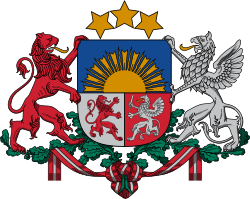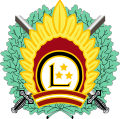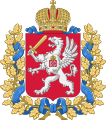Coat of arms of Latvia
| Coat of arms of Latvia | |
|---|---|
 Greater version | |
| Versions | |
 Middle version | |
 Lesser version | |
| Armiger | Republic of Latvia |
| Adopted | June 15, 1921 |
| Crest | An arc of three mullets Or |
| Shield | Per fess and in base per pale: 1st Azure, a demi-sun issuing from base Or; 2nd Argent, a lion rampant contourné Gules; 3rd Gules, a gryphon segreant brandishing in the dexter claw a sword Argent. |
| Supporters | Dexter, a lion rampant Gules, and sinister, a griffin segreant Argent; both langued Or |
| Compartment | Two oak branches fructed Vert tied together by a ribbon Sanguine charged with a bar Argent |
The Coat of arms of the Republic of Latvia was officially adopted by the Constitutional Assembly of Latvia on 15 June 1921, and entered official use starting on 19 August 1921. It was created using new national symbols, as well as elements of the coats of arms of Polish and Swedish Livonia and of the Duchy of Courland and Semigallia. Thus, the coat of arms combines symbols of Latvian national statehood, as well as symbols of its historical regions.[1] The Latvian national coat of arms was designed by Latvian artists Vilhelms Krūmiņš and Rihards Zariņš.[2][3][4]
Previously, after the proclamation of the independence of Latvia, an emblem was adopted by the People's Council of Latvia on 6 December 1918 as a 'national coat of arms'. The symbol, designed by Burkards Dzenis, consisted of a Sun (a symbol of self-determination, used in badges of the Latvian Riflemen) with 17 rays, symbolizing the counties inhabited by Latvians. The bottom of the disk was covered by a ribbon in the colors of the Latvian flag. At the center of the solar disk a letter "L" and three stars were placed. This emblem was mostly used in slightly different monochrome variations as an official seal (by the People's Council, the Constitutional Assembly and other government and military institutions, on the banknotes of the Latvian ruble, diplomatic passports etc.).[5]
Elements
[edit]The three golden stars above the shield represent the three historical regions of Latvia: Vidzeme (Swedish Livonia), Latgale (Latgalia or Polish Livonia) and Kurzeme (Courland, also Zemgale (Semigallia) as the Duchy of Courland and Semigalia) and their unity.[6]
The golden sun in a blue field represents freedom. The sun was also used as a symbol of distinction and national identity used by the Imperial Russian Army's Latvian Riflemen units during World War I.[6] During the war, the sun was fashioned with 17 rays that symbolised the 17 Latvian-inhabited districts.
The bottom part of escutcheon is divided into two fields:
- The red lion from the Coat of arms of Courland represents Courland and Semigallia.[6] The symbol appears as early as 1565 in the coat of arms of the former Duke of Courland and Semigalia.
- The silver griffin from the Coat of arms of Livonia represents Vidzeme and Latgalia.[6] The Gryf coat of arms as the heraldic symbol of the Duchy of Livonia was granted in 1566, when the territories known today as Vidzeme and Latgale had come under the control of the Grand Duchy of Lithuania and Jan Hieronimowicz Chodkiewicz was made the first governor of Duchy of Livonia (1566–78).
The red lion and silver griffin are also used as supporters.[7]
Base of the coat of arms is decorated with the branches of an oak tree, Quercus robur, which is one of Latvia's national symbols, and tied by a red-white-red ribbon.
There is also a version with a mantle, which is on display at the Plenary Chamber in the House of the Livonian Noble Corporation.
-
Emblem adopted on 6 December 1918 as a 'national coat of arms' and used until 1921. This variation was used on the first banknotes of the Latvian ruble in 1919.
-
Emblem of the Latvian National Armed Forces including the sun with 17 rays and three stars
-
An illustrative 'coat of arms' at the hall of the Constitutional Assembly of Latvia
-
Three stars on the Freedom Monument in Riga
-
Greater national coat of arms of Latvia during the first session of the 1st Saeima of the Republic of Latvia in 1922
-
The tribune decorated with tree branches tied by red-white-red ribbon during the Proclamation Day parade in 2018
Usage
[edit]The proper use of the Latvian coat of arms is firmly regulated. Three types of symbols are used: the large coat of arms, the small enhanced coat of arms and the small coat of arms.
- The Greater Coat of Arms is used by the President of Latvia, the Parliament, the Prime Minister, the Cabinet of Ministers, government ministries, the Supreme Court and Prosecutor General, as well as Latvian diplomatic and consular missions.[7]
- The Small Enhanced Coat of Arms, (the Middle version) is used by Parliament agencies, the Cabinet of Ministers and other institutions under direct or indirect supervision of government ministries.[7]
- The Small Coat of Arms is used by other government institutions, municipal authorities and educational institutions on official documents.[7]
After the Soviet occupation of Latvia in 1940, the coat of arms was used until 5 August 1940. During the existence of the Latvian Soviet Socialist Republic, the emblem of the Latvian Soviet Socialist Republic was used. The Latvian coat of arms was restored once again on 15 February 1990.[8]
Until 1 January 2014 both versions of the Latvian lats used the small coat of arms on the obverse sides of 1s, 2s, 5s, 10s, 20s and 50s coins, the large coat of arms was used on the obverse sides of Ls 1 and Ls 2 coins and the reverse sides of all banknotes. After the introduction of Euro, the small coat of arms is used on the national sides of €0.01, €0.02 and €0.05 coins, the large coat of arms is used on the national sides of €0.10, €0.20 and €0.50 coins.
On 1 January 2015, the Cabinet of Ministers introduced the uniform visual identity for governmental institutions, which uses the coat of arms in the middle, and topped with a bar of the respective color of the institution.[9][10]
Colours
[edit]The colours used in the coat of arms are defined according to the official regulation as follows:[9]
| Black | Blue | Golden | Green | Red | Silver | |
|---|---|---|---|---|---|---|
| Pantone | Black C | 286 C | 873 C / 131 C | 341 C | 186 C | 877 C / Cool Grey 4 C |
| CMYK | 0, 0, 0, 100 | 100, 66, 0, 2 | 0, 32, 100, 9 | 100, 0, 67, 29 | 0, 100, 81, 4 | 0, 0, 0, 27 |
| RGB | 0, 0, 0, 0 | 19, 73, 145 | 211, 142, 0 | 0, 124, 90 | 204, 32, 48 | 195, 196, 198 |
Historical coats of arms
[edit]See also
[edit]References
[edit]- ^ Latvijas Republikas ģerbonis
- ^ "Rihards Zariņš" (in Latvian). Nacionālā enciklopēdija. Retrieved 28 August 2022.
- ^ de Vries, Hubert. "LATVIJA". De Rode Leeuw. Retrieved 31 August 2023.
- ^ Ducmane, Kristīne. "Simboli: Latvijas ģerbonis, karogs" (in Latvian). makslaplus.lv. Archived from the original on 24 February 2014. Retrieved 31 August 2023.
- ^ Lukša, Aloizs (1998-10-22). "Latvijas ģerboņu līnijas 1918 - 1940 - Latvijas Vēstnesis" [Outlines of the coats of arms of Latvia 1918-1940]. Latvijas Vēstnesis (in Latvian). Retrieved 2023-12-17.
- ^ a b c d Žemaitis, Augustinas. "State symbols of Latvia". OnLatvia.com. Retrieved 28 August 2022.
- ^ a b c d "The Coat of Arms of Latvia". Latvijas Valsts Prezidents. Archived from the original on 10 August 2014. Retrieved 10 August 2014.
- ^ "Латвийская ССР". Heraldicum (in Russian). Russian Centre of Vexillology and Heraldry. Retrieved 4 September 2023.
- ^ a b "Valsts pārvaldes grafiskais standarts | Ministru kabinets" [The Government Visual Standard]. Cabinet of Ministers of Latvia (in Latvian). Retrieved 2023-05-03.
- ^ "Uniform Visual Identity for Latvia's Governmental Institutions". Design Studio H2E. Retrieved 2023-05-03.
External links
[edit]- Latvijas valsts ģerbonis (in Latvian) – basic info at the Cabinet of Ministers' website
















